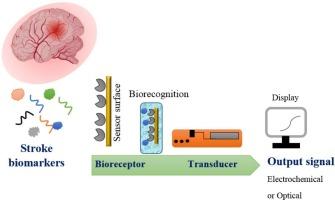中风生物标志物:即时检测的前景。
IF 2.9
3区 医学
Q2 MEDICAL LABORATORY TECHNOLOGY
引用次数: 0
摘要
中风仍然是致残和死亡的主要原因,需要快速准确的诊断工具来改善患者的预后。生物标志物如n端前b型利钠肽(NT-proBNP)、胶质纤维酸性蛋白(GFAP)、c反应蛋白(CRP)、S100B、神经丝轻链(NfL)和microrna已被引入作为早期卒中检测、亚型分化和预后的有希望的指标。然而,典型的基于实验室的分析既耗时又缺乏紧急情况所需的可移植性。生物传感器技术的最新进展,包括电化学、光学和纳米材料平台,为即时护理(POC)中风诊断提供了革命性的潜力。这些生物传感器能够超灵敏、快速、经济地检测中风生物标志物,促进及时的临床决策。本文首先综述了与缺血性卒中相关的血液生物标志物,包括基于蛋白质和RNA的生物标志物以及其他相关分子。然后,总结了最新的光学、电化学生物传感技术在脑卒中关键生物标志物检测中的应用。最后,我们讨论了用于POC设备的生物传感器技术的分析性能和进展。通过广泛讨论脑卒中生物标志物和脑卒中检测生物传感器方法的现状,本综述旨在强调这些设备在改善患者预后和推进基于脑卒中的研究中的重要性。本文章由计算机程序翻译,如有差异,请以英文原文为准。

Stroke biomarkers: the promise of point-of-care testing
Stroke remains a leading cause of disability and mortality requiring rapid and accurate diagnostic tools to improve patient outcomes. Biomarkers such as N-terminal pro B-type natriuretic peptide (NT-proBNP), glial fibrillary acidic protein (GFAP), C-reactive protein (CRP), S100B, neurofilament light chain (NfL), and microRNAs have been introduced as promising indicators for early stroke detection, subtype differentiation, and prognosis. However, typical laboratory-based assays are time-consuming and lack the portability required for emergency settings. Recent advances in biosensor technologies, including electrochemical, optical, and nanomaterial-based platforms, offer transformative potential for point-of-care (POC) stroke diagnosis. These biosensors enable ultrasensitive, rapid, and cost-effective detection of stroke biomarkers, facilitating timely clinical decision-making. This review first focuses on blood biomarkers related to ischemic stroke, including protein and RNA based biomarkers and other relevant molecules. Then, it summarizes the latest optical, and electrochemical bio-sensing techniques for the detection of critical biomarkers in stroke. Finally, we discuss analytical performance and advances in biosensor technology for use in POC devices. By providing a wide-ranging discussion on the stroke biomarkers and current state of biosensor approaches for stroke detection, this review aims to highlight the importance of these devices in improving patient outcomes and progressing stroke-based studies.
求助全文
通过发布文献求助,成功后即可免费获取论文全文。
去求助
来源期刊

Clinica Chimica Acta
医学-医学实验技术
CiteScore
10.10
自引率
2.00%
发文量
1268
审稿时长
23 days
期刊介绍:
The Official Journal of the International Federation of Clinical Chemistry and Laboratory Medicine (IFCC)
Clinica Chimica Acta is a high-quality journal which publishes original Research Communications in the field of clinical chemistry and laboratory medicine, defined as the diagnostic application of chemistry, biochemistry, immunochemistry, biochemical aspects of hematology, toxicology, and molecular biology to the study of human disease in body fluids and cells.
The objective of the journal is to publish novel information leading to a better understanding of biological mechanisms of human diseases, their prevention, diagnosis, and patient management. Reports of an applied clinical character are also welcome. Papers concerned with normal metabolic processes or with constituents of normal cells or body fluids, such as reports of experimental or clinical studies in animals, are only considered when they are clearly and directly relevant to human disease. Evaluation of commercial products have a low priority for publication, unless they are novel or represent a technological breakthrough. Studies dealing with effects of drugs and natural products and studies dealing with the redox status in various diseases are not within the journal''s scope. Development and evaluation of novel analytical methodologies where applicable to diagnostic clinical chemistry and laboratory medicine, including point-of-care testing, and topics on laboratory management and informatics will also be considered. Studies focused on emerging diagnostic technologies and (big) data analysis procedures including digitalization, mobile Health, and artificial Intelligence applied to Laboratory Medicine are also of interest.
 求助内容:
求助内容: 应助结果提醒方式:
应助结果提醒方式:


